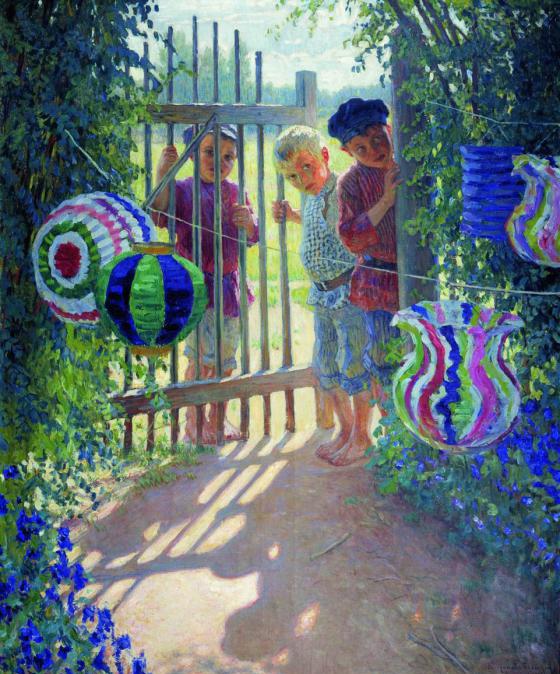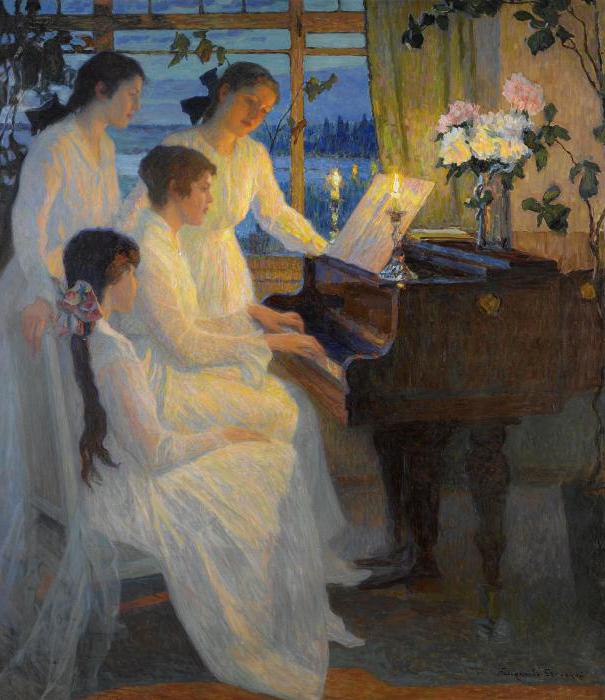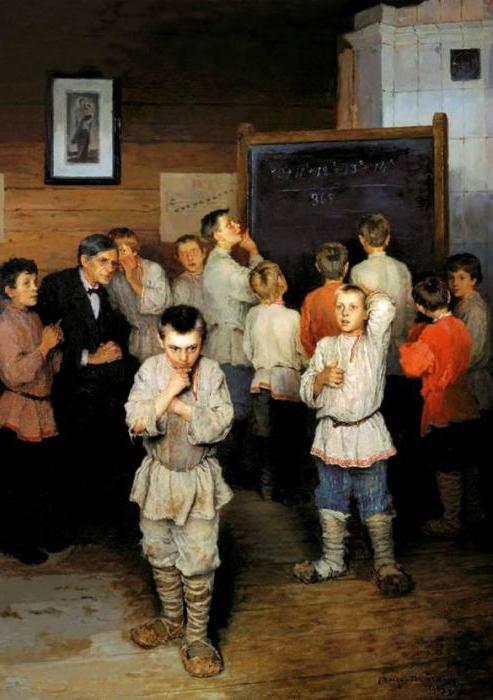The artist with a sonorous surname Bogdanov-Belsky was a native of the very bottom of society. It would seem that the environment in which he grew up was bound to grind it and absorb it, but no. The artist received education and fame. His biography is an example of not only a happy combination of circumstances, but also tireless hard work. The image of the rural school, its pupils and teachers has become one of the main in his work.
Nikolai Petrovich Bogdanov-Belsky: biography
On a frosty day on December 8, 1868, a illegitimate son was born to a Smolensk laborer. Everyone knows how society treated such children, and even from the bottom. A mother with a child “out of mercy” sheltered her older brother. Many hardships fell to the share of little Nikolai. At birth, he received the name Bogdanov - given by God. The "Belsky" artist later added himself, in honor of the county in which he grew up.
The boy received his first two years of education at a rural church school in Shopotovo. Thanks to the patronage of his teacher-priest, he got to the school of Professor Rachinsky. Simple peasant boys, like Nikolai, were trained here. This man played a decisive role in the life of the artist. Bogdanov-Belsky himself always said that he owed everything to him.

Seeing the boy’s talent for painting, Rachinsky helped him to enter the drawing school at the Trinity-Sergius Lavra, and then to the Moscow School of Painting, Sculpture and Architecture. The patron helped the boy financially, monthly allocating money for maintenance. At school, Nikolai entered the landscape class, where he worked very successfully, often being the first among classmates. The young man was very lucky with the teachers, they were wonderful Russian artists: Vasily Polenov, Vladimir Makovsky, Illarion Pryanishnikov. Nikolai pondered the topic of the graduation picture for a long time, and Rachinsky prompted it. The result of the artist’s enthusiastic work was the painting “The Future Monk”.
After graduating from the Moscow school, Bogdanov-Belsky continues his studies at the St. Petersburg Academy of Arts in the class of Ilya Repin. At the end of 1895, the graduate went to Europe: to Paris, Munich, and then to Italy. The coloring of the artist’s paintings is enriched, his possession of painting techniques is enhanced.
Fame in Russia for Bogdanov-Belsky is brought by the paintings “At the school door” and “Oral score”. Orders fell on the artist: portraits, still lifes, landscapes. He wrote the most famous and influential people of his era. His brushes belong to portraits of Emperor Nicholas II, the Grand Dukes, Fedor Chaliapin. But his favorite models are peasant guys, lively, sincere and direct.
The artist’s works were acquired by the Tretyakov Gallery, he participates in exhibitions of the Association of Wanderers. His paintings travel around Russia, then exported to Paris and Rome. At 35, Nikolai Petrovich Bogdanov-Belsky became an academician of painting, and 10 years later - a member of the Academy of Arts.
After the revolutionary government came to power, the “left” becomes official art. The persecution of realist artists begins, classical art withers and eradicates. Korovin, Polenov, Vasnetsov, Nesterov - all experienced the hardships of the post-revolutionary time. At the invitation of his friend, Bogdanov-Belsky moved to Riga. Here, the artist takes on the job with renewed vigor, actively participates in foreign exhibitions of Russian art. His paintings are successful and diverge in private collections. So far, many canvases of Bogdanov-Belsky scattered throughout Western Europe.

In 1941, a 73-year-old artist faced a new test: war. But there was no more strength left to fight, too much was passed and suffered. The artist falls ill, the creative forces leave him. Nikolai Petrovich underwent surgery in Germany, but she did not help. In 1945, during the bombing, the artist dies. He was buried at the Russian cemetery in Berlin. Pictures of Bogdanov-Belsky and now remain very popular. Some of them can be seen in the Tretyakov Gallery and the Russian Museum, many are in private collections.
The Future Monk (1889)
The idea of this picture of Bogdanov-Belsky was prompted by his friend and guardian Rachinsky. It was written in 1889.
Two people are sitting in a cramped hut room: an elderly monk wanderer and a dreaming peasant boy. The monk was telling him something, and the boy listened. Pictures of a godly, peaceful future arise before his eyes. He hears the wanderer, but his thoughts are no longer in the room, but somewhere in the unknown distances. One day, he will also go with a knapsack behind him to glorify the name of God.
The picture was written for the final exam at the school. With great anxiety, the artist expected his result: after all, he studied in a landscape class, and the painting presented a genre. Despite concerns, the painting was a success and was bought by a large collector, and then ended up in the imperial palace.
The Virtuoso (1891)
This is one of the first paintings with peasant children, which was painted by Bogdanov-Belsky. Virtuoso, it turns out, is a simple boy. Simple, but not quite. His playing the balalaika gathered around the circle of children. There are two kids, a girl and an older boy. They all listen to music, as at a concert of a great artist, catch every sound. The virtuoso himself is focused on his game. The artist placed them in a picturesque meadow in a birch forest. The landscape, sweet to every heart, harmoniously frames the group of children and, it seems, he himself hears the game of young talent.
The Oral Account (1896)
In 1896, Bogdanov-Belsky painted this picture. An essay on it is still often asked to write to children at school. In the role of a teacher, the artist portrayed his own mentor Rachinsky. Class in a rural school. There is a verbal account. The picture is filled with tension, hard work is felt in everything. The dominant place is occupied by a black slate board with a mathematical example. Around the board crowded children of different ages. The example is not simple, but try counting it in your mind! The intense work of thought is visible on every face. In the foreground, the boy rubs his chin thoughtfully. He is cut short, his naughty hair bristling with a hedgehog. Compared to other guys, he is dressed very poorly: a dirty shirt with a tattered elbow is belted with a lace, rough pants have seen better times. His face is tense: here he is, the answer is already close, is now tearing his tongue!

We do not know who all these boys will become in the future. Maybe they will continue the work of grandfathers and fathers and will remain to plow the land in the village. Maybe they’ll leave for the city and “beat out into people,” and someone will even become a teacher. One thing is for sure: none of them will turn into a parasite and loafer, all will be good.
In 1897, Pavel Tretyakov purchased Oral Account for his gallery. The picture is still popular, many stop in front of it to consider in more detail.
"At the door of the school" (1897)
Many paintings by Bogdanov-Belsky, depicting a rural child, are autobiographical. “At the door of the school” is just that. In the picture we see a clean bright class of a rural school. A slate board with evenly-drawn lines, neat rows of desks, heads diligently bowed over books. And a new disciple is looking at all this grace. Dressed boy is very poor. The jacket, made of rags, seems to be crumbling right now on it, large holes gaping on its trousers, shabby and dirty bast shoes. He stands with his back to the viewer and peers out from behind the door furtively at all this magnificence, not daring to enter. Perhaps the young shepherd Nicholas also once stood, not daring to cross the threshold of the school of his benefactor Rachinsky.
"Visitors"
Two kids, a boy and a girl, entered the manor house. Perhaps this is the young friends of the artist himself came to pose for him. Slender children are short cut and dressed in a festive manner. The girl has a bright red dress with peas, the boy has a shirt with an elegant pattern. Variegated clothing resonates with the picturesque drapery behind the backs of children. They sit on a luxurious, by their standards, soft armchair with carved handles and solemnly drink saucer tea. On the table in front of them is a cup and a glass, bagels and pieces of sugar. A visit to the manor house is not an easy event. The faces of the kids read the awareness of the solemnity of the moment, tense figures cause emotion.
The paintings of Bogdanov-Belsky always impress with their sincerity and spontaneity. It is a pity that much of the artist’s creative heritage has been lost for us: it remained abroad and went into private collections.